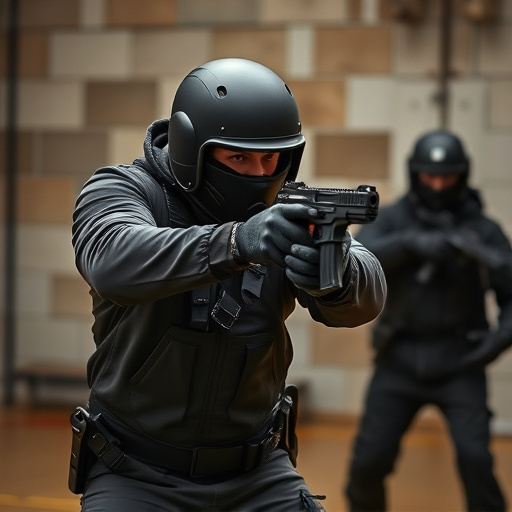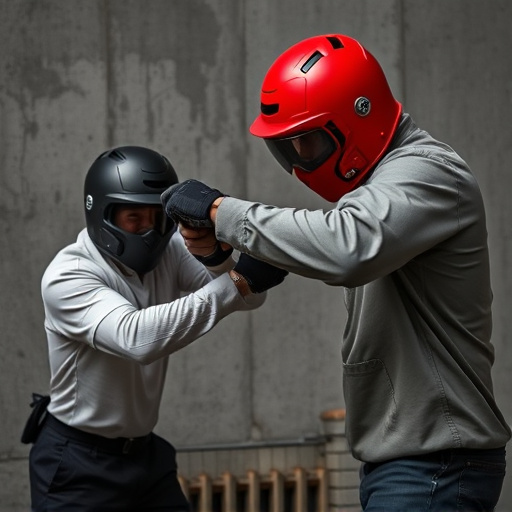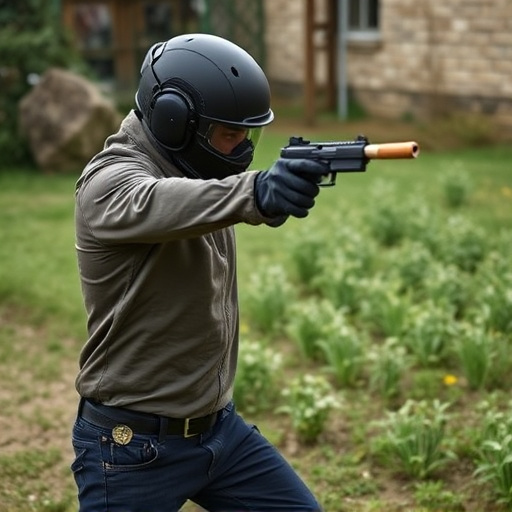Stun gun electrode spacing is a crucial factor for both safety and effectiveness. Proper placement ensures efficient current flow, disrupting an assailant's neuromuscular system without causing collateral damage. The best safety features in stun guns, including optimal electrode spacing, minimize user and bystander risk, enhancing reliability and confidence in dangerous situations. Targeted electrode placement on high conductivity areas like thighs, shoulders, or temples maximizes the disruptive effect on muscle function while preventing accidental shocks. Choosing between single-point, dual-point, or adjustable electrode spacing configurations depends on individual needs, with advanced designs offering enhanced performance, durability, ergonomics, and safety locks to prevent accidental discharge.
Stun guns, powerful tools for personal defense, rely on precise electrode spacing to deliver effective shocks. This critical factor influences both safety and effectiveness, ensuring users can defend themselves with confidence. Understanding the role of electrodes and optimal placement is essential for maximizing impact while minimizing risks. This article explores the best practices, common configurations, and factors affecting stun gun electrode performance, guiding users in choosing weapons with top-tier safety features.
- Understanding Stun Gun Electrode Spacing: A Key Factor in Safety and Effectiveness
- The Role of Electrodes in Stun Guns: Delivering Electrical Shock
- Best Practices for Optimal Electrode Placement for Maximum Impact
- Common Stun Gun Electrode Configurations: Which One is Right for You?
- Factors Influencing the Performance of Stun Gun Electrodes
- Safety Features to Consider When Choosing a Stun Gun with Effective Electrode Spacing
Understanding Stun Gun Electrode Spacing: A Key Factor in Safety and Effectiveness

Understanding Stun Gun Electrode Spacing: A Key Factor in Safety and Effectiveness
When it comes to stun guns, electrode spacing plays a pivotal role in both their safety and effectiveness. The electrodes are responsible for delivering an electric current that disrupts an assailant’s neuromuscular system, causing temporary paralysis and enabling the user to escape or seek help. Proper electrode placement ensures that the current flows efficiently through the body, maximizing its impact without causing collateral damage.
The best safety features in stun guns, including optimal electrode spacing, are designed to minimize risk to both the user and bystanders. Properly spaced electrodes reduce the likelihood of accidental shocks, making these devices safer for everyday carry. Additionally, efficient current distribution ensures that the stun gun is effective against a wide range of attackers, providing users with greater confidence and peace of mind in potentially dangerous situations.
The Role of Electrodes in Stun Guns: Delivering Electrical Shock

The electrodes in stun guns play a pivotal role in delivering an effective electrical shock, which is the primary mode of incapacitation these devices employ. Stun guns use two electrodes, typically located on the contact points where the device makes physical contact with the target. These electrodes conduct electricity, transmitting it into the body to disrupt muscle control and cause temporary paralysis. The spacing between these electrodes is a critical factor in determining the stun gun’s effectiveness.
When considering the best safety features in stun guns, electrode spacing is an essential aspect. A well-designed stun gun will have electrodes strategically placed to ensure maximum impact while minimizing the risk of accidental shocks or unintended targets. The optimal spacing allows for targeted delivery of the electrical current, maximizing its disruptive effect on muscle function without causing collateral damage. This precise design contributes to a safer and more reliable stun gun experience, ensuring users can defend themselves effectively while minimizing potential hazards.
Best Practices for Optimal Electrode Placement for Maximum Impact

When it comes to best practices for optimal electrode placement, stun gun users should aim for strategic positioning that enhances effectiveness while prioritizing safety. For maximum impact, electrodes should be positioned to deliver a concentrated electric current directly to key nerve centers. This often means aligning them with areas like the thighs, shoulders, or temples—body parts with high electrical conductivity and proximity to vital neural pathways.
Among the best safety features in stun guns is ensuring electrode spacing that allows for accurate targeting without accidental discharge. Proper spacing ensures the device delivers its full potential only when aimed correctly, minimizing risks associated with improper use. Remember, proper training and understanding of your stun gun’s mechanics are crucial to leveraging these best practices for optimal results while maintaining safety.
Common Stun Gun Electrode Configurations: Which One is Right for You?

When it comes to stun gun electrode spacing, understanding different configurations is key to choosing the right device for your safety needs. The two most common setups are single-point and dual-point electrodes. Single-point designs feature a single probe that delivers an electric shock upon contact, making them simpler but less versatile. They’re ideal for close-quarters encounters where direct contact is feasible.
Dual-point electrodes, on the other hand, offer two distinct probes set at different distances apart. This configuration allows for more flexibility in usage—you can target either nearby or distant aggressors. It’s a popular choice among professionals seeking superior control and protection due to its enhanced effectiveness during various situations. Look for stun guns with adjustable electrode spacing if you want maximum versatility, ensuring the best safety features tailored to your specific needs.
Factors Influencing the Performance of Stun Gun Electrodes

The performance and effectiveness of stun gun electrodes are influenced by several key factors, all of which contribute to the overall safety and success of the device. One of the primary considerations is electrode spacing – the distance between the positive and negative terminals on the stun gun’s probes. In general, closer electrode spacing improves conductivity and allows for more precise targeting, enhancing both the stun effect and the potential to incapacitate an attacker quickly. This is especially important in close-quarters combat scenarios where speed and accuracy are crucial for personal safety.
Another factor is the overall design of the stun gun, including its best safety features. These can include durable materials that withstand frequent use, ergonomic designs for easier handling, and advanced trigger mechanisms that prevent accidental discharges. Moreover, the presence of multiple settings allows users to adjust the intensity of the shock based on their needs, balancing effectiveness with safety. Such considerations not only improve the stun gun’s performance but also ensure its reliable operation in emergency situations.
Safety Features to Consider When Choosing a Stun Gun with Effective Electrode Spacing

When choosing a stun gun, prioritizing safety is paramount. Look for models equipped with intelligent safety features designed to minimize risks and prevent accidental discharge. Some of the best safety features in stun guns include ergonomic designs that ensure a firm grip, preventing accidental slips or drops, and advanced trigger mechanisms with safety locks. These locks require explicit activation, reducing the likelihood of unintentional use.
Additionally, consider stun guns with sensitive target acquisition systems that enhance accuracy. This feature ensures that electrodes make contact with the intended target, maximizing the effectiveness of the stun while minimizing collateral damage. Such innovative designs contribute to the overall safety and reliability of the device, making them ideal for personal protection in various situations.
When considering the best safety features in stun guns, understanding electrode spacing is paramount. Proper electrode placement ensures maximum impact while minimizing risks. By adhering to best practices and exploring different electrode configurations, users can make informed decisions to protect themselves effectively. Remember, the right stun gun with optimal electrode spacing can be a powerful tool for personal safety, providing peace of mind in potentially dangerous situations.
